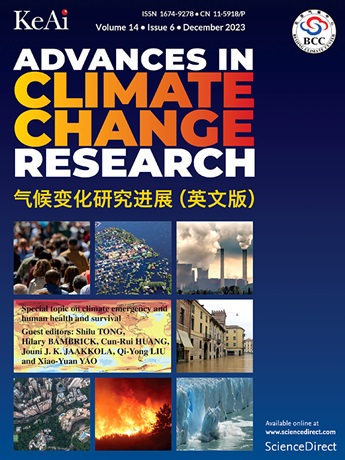气候对中国城市住宅用电量的影响
IF 5.2
1区 地球科学
Q1 ENVIRONMENTAL SCIENCES
引用次数: 0
摘要
评估气候变化的影响对于制定缓解和适应政策的有效战略至关重要。然而,由于数据匮乏,对气候变化对中国城市住宅用电量的精确影响的全面量化一直受到阻碍。本文采用一个经过验证的县级非平衡面板数据集,对中国城市住宅用电量的制冷度日(CDD)和供暖度日(HDD)的影响进行了估算。结果表明,CDD和HDD每增加1%,城市住宅单位建筑面积用电量分别相应增加0.114%和0.457%。然而,这些影响随着收入的增加而减弱,这意味着随着收入的增加,居民有更多的策略来适应气候变化。温度波动的影响在不同气候带、建筑高度和施工年份之间表现出差异。具体而言,夏热冬冷地区以及夏热冬暖地区的建筑物对温度波动的敏感性高于严寒和以寒冷为主的地区的建筑物。此外,低层建筑对温度变化的响应往往比多层和中高层建筑消耗更多的电力。有趣的是,新建筑比旧建筑更容易受到温度波动的影响。这些发现对不同气候带的气候影响提供了全面和准确的评估,使人们能够更深刻地理解气候变化。本研究提供了气候变化对建筑能源使用的影响随建筑高度而变化的实证证据,解决了以往研究中的一个关键空白。本文章由计算机程序翻译,如有差异,请以英文原文为准。
Climatic impacts on electricity consumption of urban residential buildings in China
Evaluating the effects of climate change is crucial for developing effective strategies for both mitigation and adaptation policies. However, a comprehensive quantification of the precise effects of climate change on electricity consumption in China's urban residential buildings has been hampered by the scarcity of data. Here, we employ a verified county-level unbalanced panel dataset to estimate the effect of cooling degree days (CDD) and heating degree days (HDD) on the electricity consumption of urban residential buildings in China. The results indicate that a 1% increase in CDD and HDD is linked to a corresponding rise of 0.114% and 0.457% in electricity consumption per unit of floor space in urban residential buildings, respectively. However, these effects are diminished as income increases, implying residents have more strategies to adapt to climate change as income rises. The impacts of temperature fluctuations exhibit variability across different climate zones, building heights, and construction years. Specifically, buildings in regions characterized by hot summers and cold winters, as well as those with hot summers and warm winters, exhibit greater sensitivity to temperature fluctuations compared to the buildings located in regions with severe cold and predominantly cold climates. Additionally, low-rise buildings tend to consume more electricity than multi-story and mid-to-high-rise buildings in response to temperature variation. Interestingly, new buildings are more vulnerable to temperature fluctuations than older buildings. These findings offer a comprehensive and accurate assessment of climatic impacts in different climate zones, enabling a more profound comprehension of climate change. This study provides empirical evidence that the effect of climate change on building energy use varies with building heights, addressing a critical gap in prior research.
求助全文
通过发布文献求助,成功后即可免费获取论文全文。
去求助
来源期刊

Advances in Climate Change Research
Earth and Planetary Sciences-Atmospheric Science
CiteScore
9.80
自引率
4.10%
发文量
424
审稿时长
107 days
期刊介绍:
Advances in Climate Change Research publishes scientific research and analyses on climate change and the interactions of climate change with society. This journal encompasses basic science and economic, social, and policy research, including studies on mitigation and adaptation to climate change.
Advances in Climate Change Research attempts to promote research in climate change and provide an impetus for the application of research achievements in numerous aspects, such as socioeconomic sustainable development, responses to the adaptation and mitigation of climate change, diplomatic negotiations of climate and environment policies, and the protection and exploitation of natural resources.
 求助内容:
求助内容: 应助结果提醒方式:
应助结果提醒方式:


